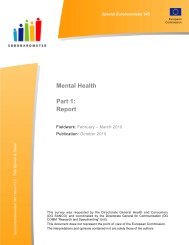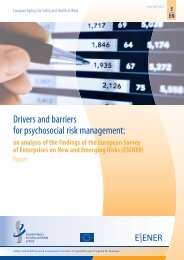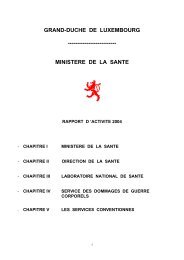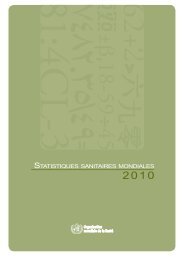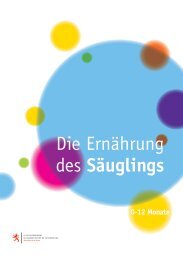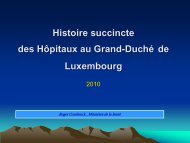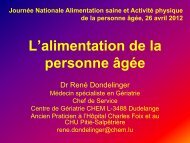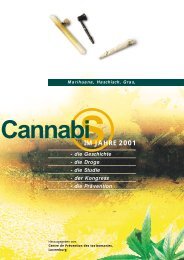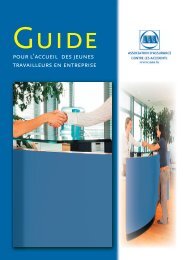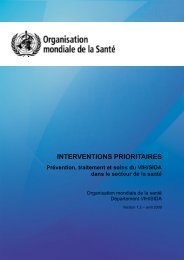healthy and active ageing - EuroHealthNet's Healthy Ageing Website
healthy and active ageing - EuroHealthNet's Healthy Ageing Website
healthy and active ageing - EuroHealthNet's Healthy Ageing Website
Create successful ePaper yourself
Turn your PDF publications into a flip-book with our unique Google optimized e-Paper software.
D. Physical activity <strong>and</strong> nutrition<br />
Physical activity <strong>and</strong> good nutrition are important components of <strong>ageing</strong> well, since they improve<br />
physical well-being while regulating stress <strong>and</strong> promoting social inclusion <strong>and</strong> participation. There are<br />
therefore a range of projects <strong>and</strong> programmes in the EU focusing on nutrition <strong>and</strong> physical activity for<br />
older people (see Boxes 18 <strong>and</strong> 19)<br />
Nutritional habits should be modified after the age of 50, as caloric needs decrease with <strong>ageing</strong><br />
(depending on activity levels), while nutritional needs increase. For example, osteoperosis is much<br />
more pronounced in older women than in men. Moreover, evidence suggests that the onset of<br />
osteoperosis can be stalled or even deterred for women if they engage in a number of preventative<br />
actions across their life course, including engaging in a sufficient level of physical activity, consuming<br />
a balanced diet <strong>and</strong> not smoking. 37 According to WHO Europe, adults need at least 30 minutes of<br />
regular, moderate-intensity physical activity on most days. More activity may be required for weight<br />
control. Physical activity benefits both physical <strong>and</strong> mental well-being, <strong>and</strong> reduces by about 50% the<br />
risk of many disorders related to inactivity (such as heart disease <strong>and</strong> type 2 diabetes), as well as<br />
reducing the risk of hypertension <strong>and</strong> some forms of cancer, <strong>and</strong> decreasing stress, anxiety, depression<br />
<strong>and</strong> loneliness. 38 The WHO indicates that these recommendations are relevant to all <strong>healthy</strong> adults. In<br />
addition, older adults with poor mobility should do physical activity to enhance balance <strong>and</strong> prevent falls<br />
three or more days per week. When older adults cannot do the recommended amount of physical activity<br />
due to health conditions, they should be as physically <strong>active</strong> as their abilities <strong>and</strong> conditions allow. 39<br />
A Crochane study of eleven studies of aerobic physical activity programmes for <strong>healthy</strong> people over<br />
the age of 55 years found that aerobic exercise interventions resulted in increased fitness of the<br />
trained group <strong>and</strong> an improvement in at least one aspect of cognitive function. 40 More recent research<br />
has also found that, in cognitively normal adults, walking six miles a week instead of being sedentary<br />
was associated with a 50% reduction in Alzheimer’s risk over 13 years. 41<br />
Box 18<br />
Key resources<br />
European Network for Action on <strong>Ageing</strong> <strong>and</strong> Physical Activity<br />
(EUNAAPA)<br />
EUNAAPA is a network that aims to improve the health, wellbeing <strong>and</strong><br />
independence of older people throughout Europe by the promotion of<br />
evidence based physical activity. EUNAAPA provides a platform to enable<br />
policy makers, providers <strong>and</strong> professionals to exchange on this topic <strong>and</strong><br />
on its integration into other policy areas.<br />
From 2006 -2008 EUNAAPA members engaged in a EC co-funded project that led to an inventory of<br />
assessment instruments for physical activity <strong>and</strong> physical functioning in older people. It also led to a best<br />
practice report on physical activity programmes <strong>and</strong> physical activity promotion strategies for older people.<br />
More information is available at:<br />
http://www.eunaapa.org/Home/<br />
37 http://www.who.int/nutrition/topics/<strong>ageing</strong>/en/index.html<br />
38 http://www.euro.who.int/en/what-we-do/health-topics/disease-prevention/physical-activity/facts-<strong>and</strong>-figures/physical-activity-to-stay-<strong>healthy</strong><br />
39 http://www.who.int/features/factfiles/physical_activity/facts/en/index5.html; http://www.who.int/dietphysicalactivity/factsheet_olderadults/en/index.html<br />
40 Angevaren M, Aufdemkampe G, Verhaar H, Aleman A, Vanhees L. Physical activity <strong>and</strong> enhanced fitness to improve cognitive<br />
function in older people without known cognitive impairment. 2008 http://www2.cochrane.org/reviews/en/ab005381.html<br />
41 http://www.webmd.com/alzheimers/news/20101128/walking-may-cut-alzheimers-risk<br />
33



